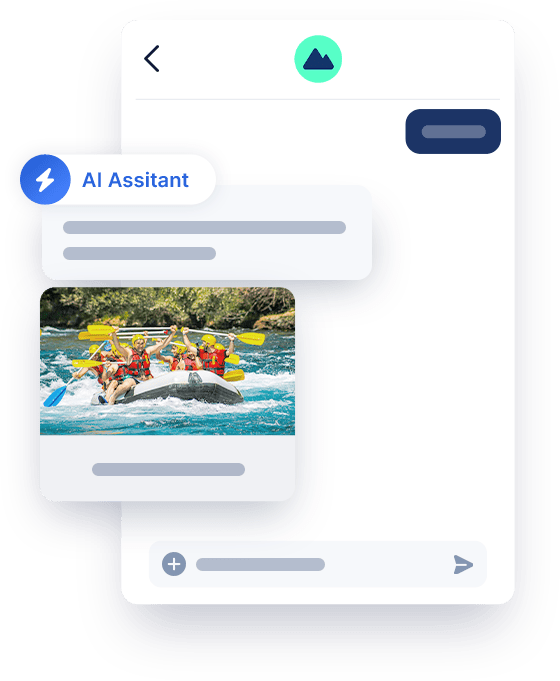5 Tips for Retailers to Reduce Call Volume

It’s peak busy season in the retail industry, but we all know what comes after the holidays. Returns will be at their highest—and you’ll be looking for ways to reduce call volume.
So what do you do when you know the slow season is coming?
Many businesses batten down the hatches during times of economic uncertainty. It’s easy to look for simple cost-cutting measures and avoid major process changes. But instead of hunkering down, now’s the time to take a deeper look at your processes and see what you can do to streamline the customer experience.
The holiday season puts pressure on your call center. Calls are at an all-time high, you’re agents are overwhelmed, but you’re looking to cut costs. The best way to do that? Look for ways to reduce call volume.
Keep reading for five ways to lighten the load on your call center.
1. Mitigate hang-ups by embracing messaging.
Hangups happen. Whether a new, inexperienced agent accidentally disconnects, an angry customer is tired of waiting, or the line just goes dead, hang-ups add to your overall call volume.
Every time a customer has to call back, you have to create a new ticket. Customers have to start the conversation from scratch and repeat their problem—something that customers hate doing that will also take up valuable agent time—all before you can solve the problem.
Embracing messaging is a great way to reduce call inefficiencies at the source. Messaging conversations don’t have to have a defined beginning and end. With conversational platforms like Quiq, conversations flow more naturally between agents and customers. Customers can pop in with a question while browsing the website or follow up on their shipping confirmation post-purchase. Without the commitment of a phone call, conversations can happen more easily.
Plus, chat history never goes away. Your agents have access to previous conversations, so customers never have to repeat information. Agents can deliver exceptional and friendly service, deliver a more personalized experience, and improve customer retention.
2. Make it easy to connect from any channel.
When phone calls are your only option for real-time customer service, you’re going to have higher call volumes. Email is a helpful alternative, but it often comes with longer response times. When a customer wants a quick answer, they’re going to pick up the phone.
Messaging falls somewhere between phone calls and email. It’s not as immediate as a phone call, but they can get answers more quickly than waiting for an email response.
Offering multiple channels, from the immediacy of live chat (also known as web chat) to more forgiving options like business text messaging, gives customers options besides the phone.
And you’re not just reducing call volume artificially by moving conversations from phone calls to messages. You’ll actually save time—even with the same number of service tickets. Since messaging is asynchronous (meaning both parties don’t have to be present at the same time), agents can increase the number of customers they’re serving at once. Agents can help 6–8 customers at the same time while providing excellent customer service. Plus, Quiq customers that implement messaging see work time reductions of up to 35%.
3. Reduce call volume by adding call-to-text to your IVR.
Reducing your call volume does take some buy-in from your customers. If they’re still used to calling you for service-related questions, it can take time to get them to embrace using alternative communication methods.
A great option to encourage text messaging by adding call-to-text to your interactive voice response (IVR) system. When customers call in, they’ll be given the option to text your customer service team instead.
This is a great option to implement during peak volume periods. When wait times increase and your team is overloaded, you can lighten the burden by encouraging customers to use call-to-text. Besides reducing call volume, customers will be pleased they don’t have to wait on-hold to get their questions answered.
4. Answer customer questions 24/7 with an ai chatbot.
Your call center will always be limited by your hours of operation. When customers have to wait to call in during business hours, your agents can quickly become overwhelmed.
Instead, give customers a chance to get their questions answered 24/7 with an AI-enhanced chatbot. Gather the most frequently asked questions and program your chatbot with the answers. By offloading simple questions, your agents will have fewer calls to manage during the day and can spend their time working on more complex customer problems.
5. Get ahead of questions.
Some questions you can’t anticipate—but some you can. Take a look at your most frequently asked questions and see how you can implement the answers throughout your customer journey.
For example, one of the most frequently asked questions for most retailers is “Where’s my order?” Many retailers have gotten ahead of this and have been able to reduce call volume by emailing customers tracking links and order statuses. But you can go an extra step by sending an outbound text message at various points, like when the order is received and once it has shipped. Customers are much more likely to read a text message than an email, which means they’re less likely to call customer service and ask.
You can also place things like your return policy, shipping costs, and store hours (if applicable) more prominently on your website. While hiding the return policy may seem like a good idea, in theory, it’ll just lead to more calls to your customer service team.
Reduce call volume with messaging.
As retailers get through the holiday season and look to do more with less, reducing call volume should be a top priority. Adding messaging to your customer service offering can not only ease the burden on your call center, but it can also give your customers a better experience.
Keep your call volume down with messaging, and manage in all with Quiq’s multi-channel conversational platform.




